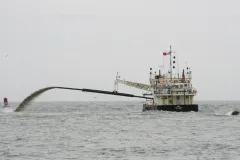Diving into the Sandstorm

Diving can be a wild ride that evokes more than a little trepidation, especially in the Pacific Ocean's famously big, cold waves. Waves that are otherwise fun for my weekend surfing can turn a scientific dive into a serious challenge. But then, diving to support the mission of the Environmental Protection Agency (EPA) can be full of surprises. At a seafloor survey site at the mouth of the Chetco River off the Oregon coast, waves transmit so much energy that divers can feel the swells nearly 80 feet down on the seafloor. As divers swim along the bottom, these swells often push them several feet forward, then “suck” them backward several feet.
Such natural water movements not only make diving difficult, but can also drastically alter the underwater terrain. Humans further these changes by digging up sand and sediment from the bottom of a river or ocean and depositing it elsewhere, a process known as dredging. Ports might dredge an area to clean up the seafloor, or make an area deep enough for large ships to navigate. Without it, sandbars would grow to such enormous heights that river entry would be worrisome to even the most experienced captains. Such large sandbars can wreck ships; one was nicknamed the “Graveyard of the Pacific” (PDF) in the early days of Columbia River navigation. And, on one beach I often surf, the wreck of the Peter Iredale remains as an eerie reminder to respect “the bar.”
But if you're going to dig up a bunch of sand, you have to put it somewhere. EPA divers around the country evaluate dredge material disposal sites regularly, where ports deposit literally tons of sand into the ocean. How much? In 2013, more than eight million cubic yards of sediment will be removed from Oregon's Columbia River alone. This, and many other dredging operations upriver, help move 42 million tons of cargo from Oregon, Washington, and Idaho farms to market each year with as few bumps as possible.
Placing dredged material from a river or harbor into the ocean is not necessarily a problem, as long as it's a load that is small enough to not overwhelm the creatures that live there, like crabs or sea stars. For example, if the load just adds several inches of sand to the area, crabs and sea stars can ‘hop’ up above that material. But if several feet were placed all at once, it’s likely that these critters would be buried. Sometimes, new sand can be beneficial to certain ecosystems, such as sandy beaches that have eroded. However, when sand is placed on rocky reefs or other sensitive environments, it can change the habitat. A rocky reef that gets buried in sand can no longer support its vital organisms, such as anemones and urchins.
That’s where the divers come in. EPA's scientific divers visit and observe dredge deposit sites to make sure there is no damage to marine life on the seafloor—critters like worms, clams, crabs, and other tiny organisms that live in the bottom sediments—as ordered by the Marine Protection, Research, and Sanctuaries Act. To do this, we visit locations before and after dredged sand has been dumped to see if habitat has changed slightly, been dramatically transformed, or remained relatively unchanged since our last visit. For some areas, we might also use remote sensing techniques like sonar to quickly direct divers toward areas that need to be monitored more closely, like those sensitive rocky reefs. If we find the impacts to an area are too severe, the dredge disposal may be moved or future deposits will be stopped altogether in that location.
Because ports continually accumulate sediment—from human dredging, natural erosion and runoff—the cycle of dredging, dumping and observation happens on a regular basis, even twice a year for some sites. All to make sure that ecosystems stay healthy, ports can continue working, and that beachgoers and surfers like me can continue to enjoy them.
Editor's Note: Read more about the latest in EPA scientific diving.


